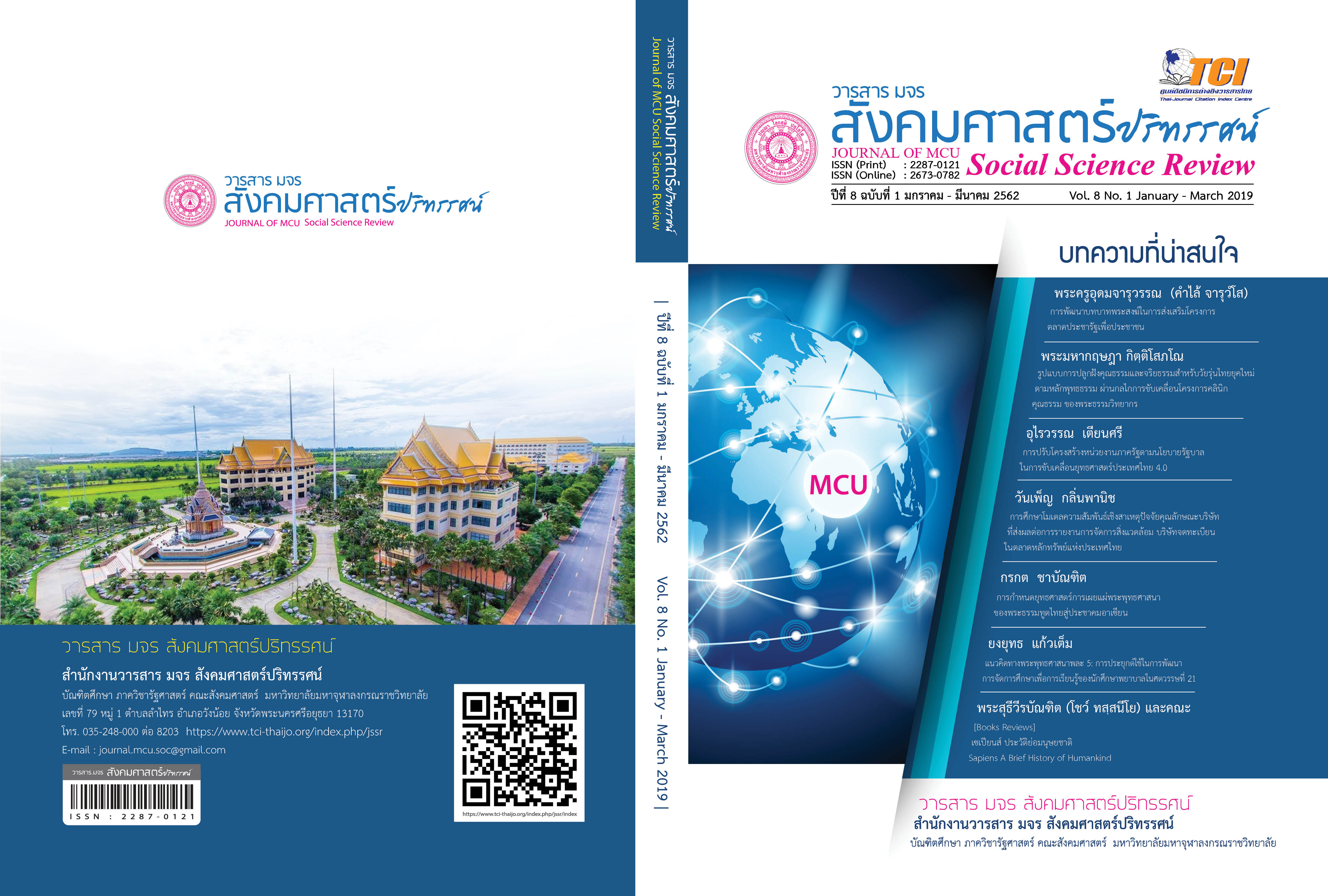รูปแบบการปลูกฝังคุณธรรมและจริยธรรมสำหรับวัยรุ่นไทยยุคใหม่ ตามหลักพุทธธรรม ผ่านกลไกการขับเคลื่อนโครงการคลินิกคุณธรรม ของพระธรรมวิทยากร
คำสำคัญ:
คุณธรรมและจริยธรรม, วัยรุ่นไทยยุคใหม่, พุทธธรรม, คลินิกคุณธรรม, พระธรรมวิทยากร.บทคัดย่อ
บทความวิจัยฉบับนี้มีวัตถุประสงค์ 3 ประการคือ 1) เพื่อศึกษาหลักการ วิธีการ และรูปแบบการปลูกฝังคุณธรรมและจริยธรรมสำหรับวัยรุ่นไทยยุคใหม่ 2) เพื่อวิเคราะห์สภาพปัญหาและอุปสรรคในการปลูกฝังคุณธรรมและจริยธรรมสำหรับวัยรุ่นไทยยุคใหม่ และ 3) เพื่อนำเสนอรูปแบบการปลูกฝังคุณธรรมและจริยธรรมสำหรับวัยรุ่นไทยยุคใหม่ ตามหลักพุทธธรรม ผ่านกลไกการขับเคลื่อนโครงการคลินิกคุณธรรม ของพระธรรมวิทยากร
การวิจัยครั้งนี้ใช้ระเบียบวิธีวิจัยแบบผสานวิธี ระหว่างการวิจัยเชิงปริมาณ ที่ใช้การศึกษาวิจัยเชิงสำรวจ จากแบบสอบถามกับกลุ่มตัวอย่างที่ใช้ในการวิจัย คือ นักศึกษา ซึ่งทำการสุ่มมาจากประชากรจำนวน 20,071 คน โดยคำนวณตามสูตรของทาโร่ ยามาเน่ (Taro Yamane) ได้กลุ่มตัวอย่างจำนวน 392 คน โดยใช้วิธีการสุ่มแบบแบ่งกลุ่ม (Cluster Sampling) ได้แก่ นักเรียน นักศึกษาจากวิทยาลัยเทคนิคราชสิทธาราม กรุงเทพมหานคร วิทยาลัยเทคโนโลยีพณิชยการอยุธยา จังหวัดพระนครศรีอยุธยา วิทยาลัยเทคนิคเชียงใหม่ จังหวัดเชียงใหม่ วิทยาลัยเทคโนโลยีภาคตะวันออกเฉียงเหนือ จังหวัดขอนแก่น และวิทยาลัยเทคนิคนครศรีธรรมราช จังหวัดนครศรีธรรมราช และการวิจัยเชิงคุณภาพ โดยทำการวิจัยเชิงเอกสารกับการสัมภาษณ์เชิงลึกจากผู้ให้ข้อมูลสำคัญ (Key Informants) ที่เป็นผู้ทรงคุณวุฒิรวมทั้งผู้บริหาร คณาจารย์ และนักวัฒนธรรมจังหวัด จำนวน 18 รูป/คน จากนั้นนำมาสังเคราะห์เป็นรูปแบบเบื้องต้น และทำการสนทนากลุ่มเฉพาะ กับผู้เชี่ยวชาญ จำนวน 9 ท่าน เพื่อสร้างรูปแบบให้มีความสมบูรณ์ยิ่งขึ้น วิเคราะห์ข้อมูลโดยใช้การวิเคราะห์เนื้อหา
ผลการวิจัยพบว่า
1) พระธรรมวิทยากรมีบทบาทสำคัญในการส่งเสริมคุณธรรมจริยธรรมในสถานศึกษา โดยมีบทบาทสำคัญ 9 ประการคือ 1. ให้คำปรึกษาแก่นักศึกษา 2. จัดสนทนาธรรมเป็นประจำ 3. มีการอบรมเยาวชนอย่างสม่ำเสมอ 4. จัดกิจกรรมทางพระพุทธศาสนาอย่างต่อเนื่อง 5. ร่วมกับสถานศึกษาจัดทำแผนปฏิบัติการประจำปี 6. จัดทำทะเบียนผู้เข้าร่วมกิจกรรม 7. พัฒนาเครื่องมือในการปรับเปลี่ยนพฤติกรรมของผู้เรียน 8. จัดค่ายคุณธรรมจริยธรรม และ 9. มีการประเมินผลกลุ่มเป้าหมายร่วมกับสถานศึกษา โดยบูรณาการกับหลักธรรมในทางพระพุทธศาสนา คือ หลักไตรสิกขา หลักอริยสัจ 4 หลักอิทธิบาท 4 และหลักภาวนา 4 มาใช้ในการส่งเสริมคุณธรรมจริยธรรมด้วย
2) สภาพปัญหาและอุปสรรคในการปลูกฝังคุณธรรมและจริยธรรมสำหรับวัยรุ่นไทยยุคใหม่ ตามหลักพุทธธรรม ผ่านกลไกการขับเคลื่อนโครงการคลินิกคุณธรรม ของพระธรรมวิทยากรพบว่า นักศึกษามีความคิดเห็นต่อรูปแบบการปลูกฝังคุณธรรมและจริยธรรมสำหรับวัยรุ่นไทยยุคใหม่ ตามหลักพุทธธรรม ผ่านกลไกการขับเคลื่อนโครงการคลินิกคุณธรรม ของพระธรรมวิทยากร ในภาพรวมอยู่ในระดับมาก ( = 4.06, S.D. = 0.510) และเมื่อพิจารณาเป็นรายด้านพบว่า อยู่ในระดับมากทุกด้าน ส่วนปัญหาและอุปสรรคในการปลูกฝังคุณธรรมและจริยธรรมสำหรับวัยรุ่นไทยยุคใหม่ ตามหลักพุทธธรรม ผ่านกลไกการขับเคลื่อนโครงการคลินิกคุณธรรม ของพระธรรมวิทยากรพบว่า พระธรรมวิทยากรสามารถนำกิจกรรมไปใช้กับนักเรียน นักศึกษาได้เป็นบางกลุ่มเท่านั้น ไม่สามารถปรับใช้กับนักเรียน นักศึกษาทุกกลุ่มได้ จึงควรปรับปรุงรูปแบบใหม่ให้สอดคล้องกับพฤติกรรมของนักเรียน นักศึกษาทุกกลุ่มโดยการนำชุมชน ผู้ปกครอง และสถานศึกษา มาช่วยสนับสนุนบทบาทของพระธรรมวิทยากรด้วย
3) รูปแบบการปลูกฝังคุณธรรมและจริยธรรมสำหรับวัยรุ่นไทยยุคใหม่ ตามหลักพุทธธรรม ผ่านกลไกการขับเคลื่อนโครงการคลินิกคุณธรรม ของพระธรรมวิทยากร พบว่ามี 4 รูปแบบ คือ 1) รูปแบบการป้องกัน (Prevention) 2) รูปแบบการปรับปรุง (Improvement) 3) รูปแบบการเปลี่ยนแปลง (Change) และ 4) รูปแบบการพัฒนา (Development) ทั้งนี้รูปแบบดังล่าวจะประสบผลสำเร็จได้ก็ต่อเมื่อได้รับการสนับสนุนจากสถานศึกษา (School) ชุมชน (Community) และผู้ปกครอง (Parent) โดยร่วมกันดำเนินการดังนี้คือ 1) สร้างภูมิคุ้มกันด้วยการเสริมสร้างคุณธรรมจริยธรรมอย่างจริงจัง 2) ปรับเปลี่ยนพฤติกรรมของนักเรียน นักศึกษากลุ่มเสี่ยงให้เป็นคนดีมีคุณธรรม 3) ส่งเสริมให้นักเรียน นักศึกษากลุ่มเป้าหมาย มีคุณธรรมจริยธรรม และ 4) เสริมสร้างกิจกรรมการพัฒนาคุณธรรมจริยธรรมของนักเรียน นักศึกษาร่วมกับ หน่วยงาน สถานศึกษา และชุมชน
เอกสารอ้างอิง
Beatrice Heuser. The Evolution of Strategy: Thinking War from Antiquity to the Present. Cambridge University Press. 2010.
John M. Bryson. Strategic Planning for Public Service and Non-Profit Organizations. Oxford : Pergamom Press, 1993.
Keeves. P. J.. Educational research methodology and measurement : An international handbook Oxford. England : Pergamon Press, 1988.
Lee J. Cronbach. Essentials of psychological testing. 4th ed.. New York : Harper & Row, 1971.
Robbins. S. P. and Coulter. M. Management. 9th ed.. London : Prentice- Hall, 2007.
Smith. R. H.. and Others. Measurement : Making Organization Perform. New York : Macmillan, 1980.
Wheelen. T. L. & Hunger. D. L.. Strategic Management and Business Policy. New York : Addison-Wesley Publishing, 2000.
ดาวน์โหลด
เผยแพร่แล้ว
รูปแบบการอ้างอิง
ฉบับ
ประเภทบทความ
สัญญาอนุญาต
ลิขสิทธิ์ (c) 2019 วารสาร มจร สังคมศาสตร์ปริทรรศน์

อนุญาตภายใต้เงื่อนไข Creative Commons Attribution-NonCommercial-NoDerivatives 4.0 International License.
เพื่อให้เป็นไปตามกฎหมายลิขสิทธิ์ ผู้นิพนธ์ทุกท่านต้องลงลายมือชื่อในแบบฟอร์มใบมอบลิขสิทธิ์บทความให้แก่วารสารฯ พร้อมกับบทความต้นฉบับที่ได้แก้ไขครั้งสุดท้าย นอกจากนี้ ผู้นิพนธ์ทุกท่านต้องยืนยันว่าบทความต้นฉบับที่ส่งมาตีพิมพ์นั้น ได้ส่งมาตีพิมพ์เฉพาะในวารสาร มจร สังคมศาสตร์ปริทรรศน์ เพียงแห่งเดียวเท่านั้น หากมีการใช้ภาพหรือตารางหรือเนื้อหาอื่นๆ ของผู้นิพนธ์อื่นที่ปรากฏในสิ่งตีพิมพ์อื่นมาแล้ว ผู้นิพนธ์ต้องขออนุญาตเจ้าของลิขสิทธิ์ก่อน พร้อมทั้งแสดงหนังสือที่ได้รับการยินยอมต่อบรรณาธิการ ก่อนที่บทความจะได้รับการตีพิมพ์ หากไม่เป็นไปตามข้อกำหนดเบื้องต้น ทางวารสารจะถอดบทความของท่านออกโดยไม่มีข้อยกเว้นใดๆ ทั้งสิ้น





